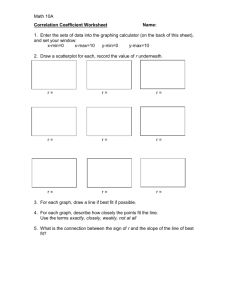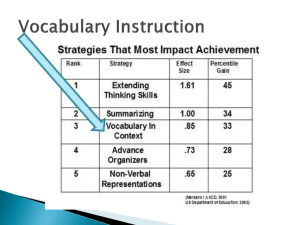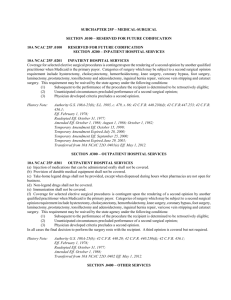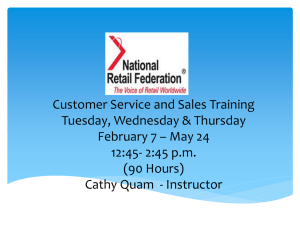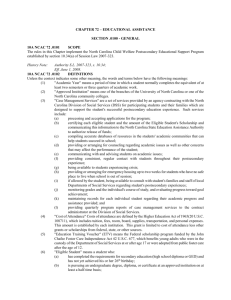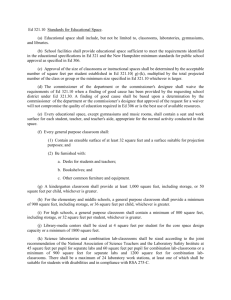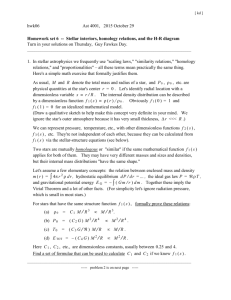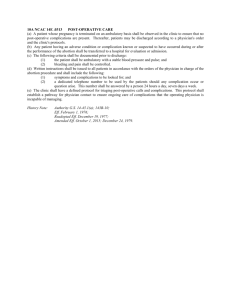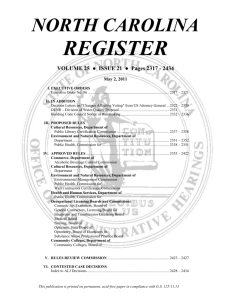General Requirements Rules 0601-0604 1001-1004 0512
advertisement
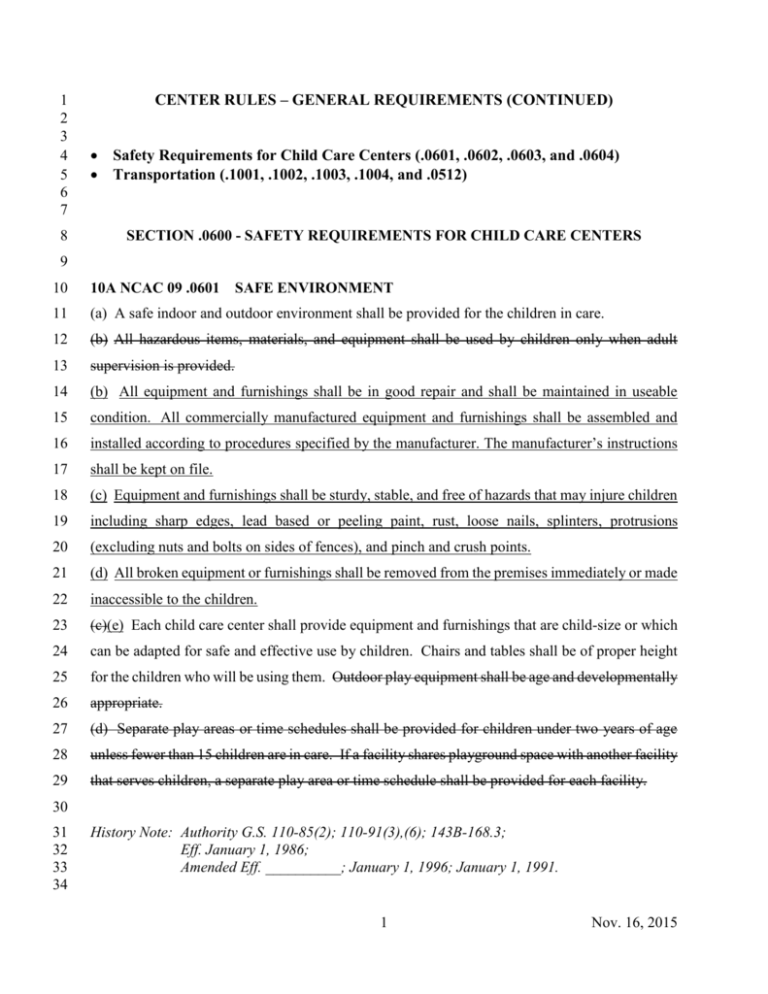
1 2 3 4 5 6 7 8 CENTER RULES – GENERAL REQUIREMENTS (CONTINUED) Safety Requirements for Child Care Centers (.0601, .0602, .0603, and .0604) Transportation (.1001, .1002, .1003, .1004, and .0512) SECTION .0600 - SAFETY REQUIREMENTS FOR CHILD CARE CENTERS 9 10 10A NCAC 09 .0601 SAFE ENVIRONMENT 11 (a) A safe indoor and outdoor environment shall be provided for the children in care. 12 (b) All hazardous items, materials, and equipment shall be used by children only when adult 13 supervision is provided. 14 (b) All equipment and furnishings shall be in good repair and shall be maintained in useable 15 condition. All commercially manufactured equipment and furnishings shall be assembled and 16 installed according to procedures specified by the manufacturer. The manufacturer’s instructions 17 shall be kept on file. 18 (c) Equipment and furnishings shall be sturdy, stable, and free of hazards that may injure children 19 including sharp edges, lead based or peeling paint, rust, loose nails, splinters, protrusions 20 (excluding nuts and bolts on sides of fences), and pinch and crush points. 21 (d) All broken equipment or furnishings shall be removed from the premises immediately or made 22 inaccessible to the children. 23 (c)(e) Each child care center shall provide equipment and furnishings that are child-size or which 24 can be adapted for safe and effective use by children. Chairs and tables shall be of proper height 25 for the children who will be using them. Outdoor play equipment shall be age and developmentally 26 appropriate. 27 (d) Separate play areas or time schedules shall be provided for children under two years of age 28 unless fewer than 15 children are in care. If a facility shares playground space with another facility 29 that serves children, a separate play area or time schedule shall be provided for each facility. 30 31 32 33 34 History Note: Authority G.S. 110-85(2); 110-91(3),(6); 143B-168.3; Eff. January 1, 1986; Amended Eff. __________; January 1, 1996; January 1, 1991. 1 Nov. 16, 2015 1 10A NCAC 09 .0602 2 CONDITION OF INDOOR EQUIPMENT AND FURNISHINGS 3 (a) All equipment and furnishings shall be in good repair and shall be maintained in useable 4 condition. All commercially manufactured equipment and furnishings shall be assembled and 5 installed according to procedures specified by the manufacturer. 6 (b) Equipment and furnishings shall be sturdy, stable, and free of hazards that may injure children 7 including sharp edges, lead based paint, loose nails, and splinters. 8 (c) All broken equipment or furnishings shall be removed from the premises immediately or made 9 inaccessible to the children. 10 11 12 13 14 15 16 17 History Note: Authority G.S. 110-91(6); 143B-168.3; Eff. January 1, 1986; Amended Eff. January 1, 1996; January 1, 1991; Temporary Amendment Eff. October 1, 1997; Amended Eff. July 1, 1998; Repealed Eff. ______________. 18 10A NCAC 09 .0603 19 A safe and comfortable bed, crib, or cot, equipped with a firm waterproof mattress at least four 20 inches thick will be provided for each child who remains in the center after midnight. OVERNIGHT FURNISHINGS 21 22 23 24 25 26 History Note: Authority G.S. 110-91(6); 143B-168.3; Eff. January 1, 1986; Amended Eff. January 1, 1991; Repealed Eff. ___________. 27 10A NCAC 09 .0604 SAFETY REQUIREMENTS 28 (a) In child care centers, potentially hazardous items, such as including but not limited to, archery 29 equipment, hand and power tools, nails, chemicals, propane stoves, lawn mowers, and gasoline or 30 kerosene, whether or not intended for use by children, shall be stored in locked areas, or shall be 31 removed from the premises or otherwise inaccessible to children. 32 (b) Firearms and ammunition are prohibited in a licensed child care facility unless carried by a 33 law enforcement officer. 2 Nov. 16, 2015 1 (c) Electrical outlets not in use which are When not in use, electrical outlets and power strips 2 located in space used by the children shall have approved safety outlets or be covered with safety 3 plugs unless located behind furniture or equipment that cannot be moved by a child. 4 (d) Electric fans shall be mounted out of the reach of children or shall be fitted with a mesh guard 5 to prevent access by children. 6 (e) All electrical appliances shall be used only in accordance with the manufacturer's instructions. 7 For appliances with heating elements, such as bottle warmers, crock pots, irons, coffee pots, or 8 curling irons, neither the appliance nor the cord, if applicable, shall be accessible to preschool-age 9 children. 10 (f) Electrical cords shall not be accessible to infants and toddlers. Extension cords, except as 11 approved by the local fire inspector, shall not be used. Frayed or cracked electrical cords shall be 12 replaced. 13 (g) All materials used for starting fires, such as matches, matches and lighters, and accelerants 14 shall be kept in locked storage. storage or shall be stored out of the reach of children. 15 (h) Smoking Smoking, including use of e-Cigarettes, is not permitted in space used by children 16 when children are present. on the premises of the child care center. All smoking materials shall 17 be kept in locked storage. storage or out of the reach of children. 18 (i) Fuel burning heaters, fireplaces, and floor furnaces shall be provided with a protective screen 19 attached securely to supports to prevent access by children and to prevent objects from being 20 thrown into them. 21 (j) Toxic plants Plants shall be inaccessible to children. children that are toxic shall not be in 22 indoor or outdoor space that is used by or is accessible to children. 23 (k) Air conditioning units shall be located so that they are not accessible to children or shall be 24 fitted with a mesh guard to prevent objects from being thrown into them. 25 (l) Gas tanks and gas or charcoal grills shall be located so they are not accessible inaccessible to 26 the children or shall be in a protective enclosure or surrounded by a protective guard. 27 (m) Cribs and playpens shall be placed so that the children occupying them shall not have access 28 to cords or ropes, such as venetian blind cords. 29 (n) Once a day, prior to initial use, the indoor and outdoor premises shall be checked for debris, 30 vandalism, and broken equipment. Debris shall be removed and disposed. disposed of. 3 Nov. 16, 2015 1 (o) Plastic bags, toys, and toy parts small enough to be swallowed, and materials that can be easily 2 torn apart such as foam rubber and styrofoam, shall not be accessible to children under three years 3 of age, except that styrofoam plates and larger pieces of foam rubber may be used for supervised 4 art activities and styrofoam plates may be used for food service. Latex and Jump ropes rubber 5 balloons, and rubber bands shall not be accessible to children under five years of age. age without 6 adult supervision. Balloons shall be prohibited. 7 (p) When non-ambulatory children are in care, a crib or other device shall be available for 8 evacuation in case of fire or other emergency. The crib or other device shall be fitted with wheels 9 in order to be easily moveable, have a reinforced bottom, and shall be able to fit through the 10 designated fire exit. For centers that do not meet institutional building code, and the exit is more 11 than eight inches above grade, the center shall develop a written plan to ensure a safe and 12 immediate evacuation of the crib or other device. The operator shall physically demonstrate this 13 written plan to the Division for review and approval. During the required fire, lockdown, or 14 shelter-in-place drills, an evacuation crib or other device shall be used in the manner described in 15 the Emergency Preparedness and Response Plan as defined in 10A NCAC 09 .0607(c). 16 (q) A first aid kit shall always be available on site. site and easily accessible to staff. Each staff 17 member shall be aware of the location of the first aid kit. 18 (r) Fire drills shall be practiced monthly in accordance with 10A NCAC 09 .0607(a) and records 19 shall be maintained as required by 10A NCAC 09 .0302(d)(5). 20 (s) A "shelter in place drill" or "lockdown drill" as defined in 10A NCAC 09 .0102 shall be 21 conducted at least every three months and records shall be maintained as required by 10A NCAC 22 09 .0302(8). 23 (t) Each center shall establish safe procedures for pick-up and delivery of children. These 24 procedures shall be communicated to parents, and a copy shall be posted in the center where they 25 can be seen by the parents. 26 27 28 29 30 31 32 33 34 35 History Note: Authority G.S. 110-85; 110-91(3),(6); 143B-168.3; Eff. January 1, 1991; Amended Eff. January 1, 1996; November 1, 1991; Temporary Amendment Eff. October 1, 1997; Amended Eff. __________; July 1, 2015; February 1, 2012; July 1, 2010; December 1, 2007; April 1, 2001; July 1, 1998. 4 Nov. 16, 2015 1 2 3 SECTION .1000 - TRANSPORTATION STANDARDS 10A NCAC 09 .1001 4 (a) Each When the vehicle is in motion, each adult and child shall be restrained with an 5 individual seat belt or appropriate child restraint device when the vehicle is in motion. child 6 safety seat appropriate to the child’s age or weight in accordance with North Carolina 7 Department of Public Safety requirements located at https://www.ncdps.gov/Index2.cfm. 8 (b) Only one person shall occupy each seat belt or child restraint device. safety seat. 9 (c) Children shall not occupy the front seat if the vehicle is equipped with an operational passenger SEAT RESTRAINTS AND CHILD SAFETY SEATS 10 side airbag. 11 (d) Except for when children under two years of age are transported, the restraint requirements in 12 this Rule do not apply to vehicles not required by federal or state law to be equipped with seat 13 restraints. child safety seats or seatbelts, unless those vehicles are equipped with such restraints. 14 15 16 17 18 19 History Note: Authority G.S. 110-85; 110-91; 110-91(13); 143B-168.3; Eff. January 1, 1986; Amended Eff. ____________; July 1, 1998; July 1, 1995; November 1, 1989; July 1, 1988; January 1, 1987. 20 10A NCAC 09 .1002 SAFE VEHICLES 21 (a) All vehicles Vehicles used to transport children shall be in good repair, safe, and free of hazards 22 such as torn upholstery that allows children to remove the interior padding or hurt themselves, 23 broken windows, and holes in the floor or roof. roof, or tire treads of less than 2/32 of an inch. 24 (b) Vehicles used to transport children shall comply with all applicable State and federal laws and 25 regulations. 26 (b)(c) Vehicles shall be insured for liability as required by State laws governing transportation of 27 passengers. 28 (c)(d) Vehicles used to transport children in snowy, icy, and other hazardous weather conditions 29 must be equipped with snow tires, chains, or other safety equipment as appropriate. 30 31 32 33 34 History Note: Authority G.S. 110-85; 110-91; 110-91(13); 143B-168.3; Eff. January 1, 1986; Amended Eff. ____________; July 1, 1998. 5 Nov. 16, 2015 1 10A NCAC 09 .1003 SAFE PROCEDURES 2 (a) The driver or other adult in the vehicle shall assure that all children are transferred to a 3 responsible person who is indicated on the child's application as specified in Rule .0801(a)(4) of 4 this Chapter or as authorized by the parent. 5 (b) Each center shall establish safe procedures for pick-up and delivery of children. These 6 procedures shall be communicated to parents, and a copy shall be posted in the center where they 7 can be seen by the parents. Centers licensed for three to 12 children located in a residence are not 8 required to post these procedures. 9 (c) A first-aid kit and fire extinguisher shall be located in each vehicle used on a regular basis to 10 transport children. The first-aid kit and fire extinguisher shall be firmly mounted or secured if kept 11 in the passenger compartment. 12 (d) For each child being transported, emergency and identifying information information, 13 including the child’s name, photograph, emergency contact information, a copy of the emergency 14 medical care information form required by Rule .0802(b) of this Chapter, and seating chart shall 15 be in the vehicle. 16 (e) The driver shall: 17 (1) be 21 years old or a licensed bus driver; 18 (2) have a valid driver's license of the type required under North Carolina Motor 19 Vehicle Law for the vehicle being driven or comparable license from the state in 20 which the driver resides; and 21 22 (3) have no convictions of Driving While Impaired (DWI) or any other impaired driving offense within the previous three years. 23 (f) Each person in the vehicle shall be seated in the manufacturer's designated areas. No child 24 shall ride in the load carrying area or floor of a vehicle. 25 (g) Children shall not be left in a vehicle unattended by an adult. 26 (h) Children shall be loaded and unloaded from curbside or in a safe, off-street area, out of the 27 flow of traffic, so that they are protected from all traffic hazards. 28 (i) Before children are transported, written permission from a parent shall be obtained that shall 29 include when and where the child is to be transported, expected time of departure and arrival, and 30 the transportation provider. 6 Nov. 16, 2015 1 (j) Parents may give standing permission, valid for up to 12 months, for routine transport of 2 children to and from the center. 3 (k) When children are transported, staff in each vehicle shall have a functioning cellular telephone 4 or other functioning two-way voice communication device with them for use in an emergency. 5 Staff shall not use cellular telephones or other functioning two-way voice communication devices 6 except in the case of an emergency and only when the vehicle is parked in a safe location. 7 (l) For routine transport of children to and from the center, staff shall have a list of the children 8 being transported. Staff members shall use this list to check document attendance as children 9 board the vehicle and as they depart the vehicle. A list of all children being transported shall also 10 be available at the center. 11 12 13 14 15 16 History Note: Authority G.S. 110-85; 110-91; 110-91(13); 143B-168.3; Eff. January 1, 1986; Amended Eff. ___________; December 1, 2014; November 1, 2007; July 1, 1998; October 1, 1991; January 1, 1987. 17 10A NCAC 09 .1004 STAFF/CHILD RATIOS 18 (a) When children aged two years and older are being transported, the staff/child ratios required 19 for compliance with child care center regulations as set forth in Section .0700 of this Subchapter 20 Chapter shall apply. 21 (b) When three or more children under the age of two years are being transported, the staff/child 22 ratio requirements for child care centers set forth in Section .0700 of this Subchapter Chapter for 23 children under age two shall be maintained. The driver shall not be counted in the staff/child 24 ratio. 25 26 27 28 History Note: Authority G.S. 110-85; 110-91(13); 143B-168.3; Eff. January 1, 1986; Amended Eff. _____________; July 1, 1998; July 1, 1988. 29 30 31 32 33 7 Nov. 16, 2015 1 10A NCAC 09 .0512 .1004 2 (a) Off premise activities refer to any activity which takes place away from a licensed and 3 approved space. Licensed and approved space includes "primary space" as described in 10A 4 NCAC 09 .1401(a), outdoor space as described in 10A NCAC 09 .1402, single use rooms, or other 5 administrative areas. 6 (b) When children participate in off premise activities the following shall apply: 7 (1) 8 9 Children under the age of three shall not participate in off premise activities that involve children being transported in a motor vehicle. (2) 10 11 OFF PREMISE ACTIVITIES When children are transported in a motor vehicle for off premise activities, the provisions in Rule .1003(c) through (i) and (k) of this Chapter shall apply. (3) Before staff members walk children off premises for play or outings, the parent of 12 each child shall give written permission for the child to be included in such 13 activities. 14 (4) Parents may provide a written statement giving standing permission which may be 15 valid for up to 12 months for participation in off premise activities that occur on a 16 regular basis. 17 (5) The facility shall post a schedule of off premise activities in each participating 18 classroom where it can be easily viewed by parents, and a copy shall be given to 19 parents. The schedule shall be current and shall include the: 20 (A) location of the activity, 21 (B) purpose of the activity, 22 (C) time the activity will take place, 23 (D) date of the activity; and 24 (E) name of the person(s) to be contacted in the event of an emergency. 25 (6) Each time that children are taken off the premises, staff shall take a list of the 26 children participating in the activity with them. Staff members shall use this list to 27 check attendance when leaving the facility, periodically when the children are 28 involved in the activity, before leaving the activity to return to the child care 29 facility, and upon return to the facility. A list of all children participating in the off 30 premise activity shall also be available at the center. 8 Nov. 16, 2015 1 (c) The provisions of Subparagraphs (b)(1) and (5) of this Rule shall be waived, to the extent 2 necessary, to implement any child's Individualized Family Service Plan (IFSP) or Individualized 3 Education Program (IEP). 4 5 6 7 8 9 10 History Note: Authority G.S. 110-85; 110-91(9),(12); 143B-168.3; Eff. November 1, 2007; Prior to amendment of __________ this language was located in Rule .0512; Amended Eff. ___________. 9 Nov. 16, 2015

